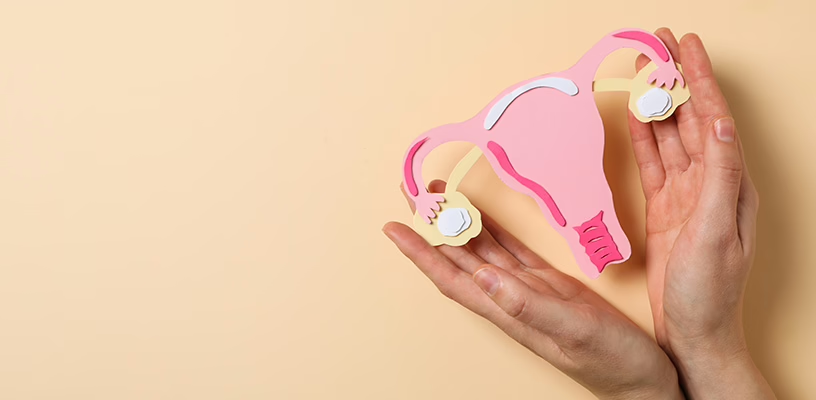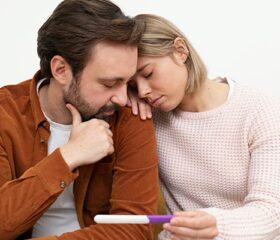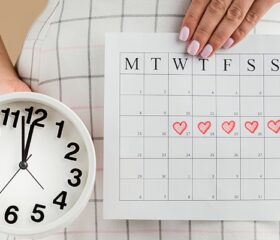Understanding Ovarian Follicles and How They Affect Fertility
Whether you’re aiming to have a baby naturally or through other means, such as in vitro fertilization (IVF), it’s good to have a deeper understanding of the biology that will produce your little bundle of joy.

One good place to start is by learning about your ovarian follicles. If you’re reading up on pregnancy, there’s a chance you’ve encountered that term before, especially if you’ve been looking into fertility testing or treatments. This article will demystify your ovarian follicles and explain how they influence your ability to get pregnant.
What are ovarian follicles?
Ovarian follicles are tiny, fluid-filled sacs inside your ovaries. Each follicle houses one immature egg, called an oocyte.
You have 1–2 million of these follicles (and eggs) at birth. This number drops to around 300,000 to 400,000 by the start of puberty. Very few follicles make it all the way to menopause. 1
The journey of a follicle: growth and maturation
Follicles begin their journey in a female fetus as “primordial follicles,” meaning they’re dormant and very small. They remain in this state until puberty rears its head. At this point, they grow slightly larger and “activate,” becoming “primary follicles.”
Each time you have a menstrual cycle, your body will pick several follicles to undergo further development. This process takes several months, meaning that at any given time, you’ll have follicles at different stages inside your ovaries.
When ovulation rolls around, a few of your follicles will swell even further and become “antral follicles.” 2 Most of the time, one will become dominant, dwarfing the others as the largest follicle in the ovary. When it does, it wins the right to release its egg for that menstrual cycle, and the other contenders shrivel back (regress). 3
Ovulation: the release of the egg
Once the dominant follicle reaches the right size (17–27 mm in diameter), it ruptures and drops a mature egg. This is what’s actually happening when you’re ovulating. 4
This egg then makes its way into the fallopian tube and waits for the sperm to arrive. If that happens within a day or so, you’ll conceive. On the other hand, if no sperm shows up, the egg will degenerate.
What happens to the follicle after ovulation?
After dropping the egg, the abandoned follicle seals itself up and morphs into a new structure called a corpus luteum. It secretes hormones, primarily progesterone and estrogen, to help the uterine lining prepare for the implantation of a fertilized egg.
If pregnancy doesn’t happen, the corpus luteum breaks down, and the menstrual cycle continues, eventually segueing into your period. 5
Why are follicles important for fertility?
Your follicle status is one of the factors that affect your fertility, and doctors use it to assess your reproductive health. Broadly speaking, the more antral follicles you have, the more fertile you probably are.
Checking your fertility with the antral follicle count (AFC) test
Specialists can use transvaginal ultrasounds to check the number of antral follicles in your ovaries. This test is referred to as the “antral follicle count” (AFC) test.
The AFC test is quick and is similar to a pelvic exam, and can be performed on days 2, 3, and 5 of your cycle. 6 At this point, your antral follicles will be 2–10 mm in diameter.
Note that AFC measures egg quantity, not quality, with the latter being just as important when it comes to fertility. This means that an AFC test isn’t the only relevant test when you’re checking your fertility, but it can provide an important piece of the puzzle.
What is a “normal” follicle count?
There’s no one “normal” antral follicle count, since factors like age, general health, and lifestyle make every woman unique. That said, generally, you’ll have more antral follicles when you’re younger, and the number will decline with age.
Here are rough benchmarks for different stages of your life: 7
- Women aged 20–24 often have 12–30 antral follicles per cycle.
- Women aged 25–34 often have 13–25 follicles
- Women aged 35 to 40 often have 10–15 follicles.
- Women aged 41 to 45 often have 3–10 follicles
- Women aged 46+ typically have 0–3 follicles
The more follicles the ultrasound reveals, the more fertile you likely are, since a higher number is correlated with having more eggs left (referred to as having a higher “ovarian reserve”).
What do lower and higher follicle counts suggest about your fertility?
A lower count (below 5–7 follicles) doesn’t necessarily mean infertility, but it does signal a lower ovarian reserve, which could mean you’ll find it harder to get pregnant and have less time until you hit menopause. 8
With that said, having a larger antral follicle count isn’t always a good thing, either. A higher-than-average number can point to conditions like polycystic ovary syndrome (PCOS), a condition that means your follicles aren’t maturing and releasing eggs properly. 9 10
The result is cyst formation and high levels of androgens (male hormones), both of which can disrupt your menstrual cycle and can cause fertility issues and symptoms like irregular periods and weight gain.
If your AFC is outside the norm in either direction, a doctor can perform an ultrasound and blood test to identify more specific problems and recommend treatments, like medication or IVF, assuming your goal is pregnancy.
What happens to your follicles when you get fertility treatments
Understanding your follicles is important when fertility treatment comes into play. Here are a few things you should know:
Follicle stimulation and extraction during IVF
In vitro fertilization is the process of extracting one of your eggs and fertilizing it in a laboratory. It’s one of the most common types of fertility treatment.
During IVF, fertility medications stimulate your ovaries to produce multiple mature follicles and, in turn, viable eggs. Your doctor monitors this development via pelvic ultrasounds throughout your cycle to track the size and number of follicles per ovary.
When the follicles reach the optimal size, your doctor administers a trigger shot to prompt the final maturation of your eggs. 11 About 36 hours later, they’ll perform an ultrasound and use a needle to retrieve the eggs from each follicle (follicular aspiration). 12
How many follicles are ideal for IVF?
IVF doesn’t guarantee a successful pregnancy, but having multiple mature eggs increases the odds of creating viable embryos for transfer and fertilization. Many IVF clinics aim to collect 10–15 eggs per cycle.
Final thoughts
So there you have it—a breakdown of your ovarian follicles and why they’re important to your fertility profile. Hopefully, you can now relax a little, knowing you have a firmer grasp on one of the most critical parts of your reproductive profile.
If you have any lingering questions or concerns about your fertility, chat with your doctor or a fertility specialist. They’ll tell you everything you need to know and give you some guidance on whether you need any tests or treatments.
Article Sources
- Rogel Cancer Center. "Normal Ovarian Function" Retrieved April 15, 2025.
- The UCSF Center for Reproductive Health. "Ovarian Reserve Testing" Retrieved April 15, 2025.
- University of California San Francisco. "The Menstrual Cycle" Retrieved April 15, 2025.
- Radiopaedia. "Follicular monitoring" Retrieved April 15, 2025.
- Radiopaedia. "Corpus luteum" Retrieved April 15, 2025.
- Radiopaedia. "Antral follicle count" Retrieved April 15, 2025.
- Fertility and Sterility. "Antral follicle counts by transvaginal ultrasonography are related to age in women with proven natural fertility" Retrieved April 15, 2025.
- Society for Assisted Reproductive Technology. "Evalutation before IVF" Retrieved April 15, 2025.
- Johns Hopkins Medicine. "Polycystic Ovary Syndrome (PCOS)" Retrieved April 15, 2025.
- MedlinePlus. "Polycystic ovary syndrome" Retrieved April 15, 2025.
- Penn Medicine Lancaster General Health. "Ovulation Induction" Retrieved April 15, 2025.
- Yale Medicine. "In Vitro Fertilization (IVF)" Retrieved April 15, 2025.







